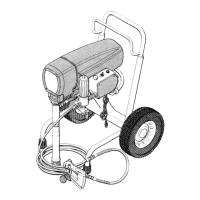4. Cleaning a Clogged Tip
WARNING
To reduce the risk of serious bodily injury from in-
jection, use extreme caution when cleaning or
changing spray tips. If the spray tip clogs while
spraying, engage the gun safety latch immediate-
ly, then follow the procedure in Steps 4a-4e,
below.
NEVER wipe off build up around the spray tip until
pressure is fully relieved and the gun safety latch is
engaged.
a. Clean the front of the tip frequently during the
day’s operation.
First,
follow the
Pressure
Relief Procedure Warning
in on page 10.
Then use a solvent-soaked brush to keep fluid
from building up and clogging the tip.
b. If the spray tip does clog, release the gun trig-
ger, engage the gun safety, and rotate the
spray tip handle 1W. See Fig 6.
c. Disengage the gun safety and trigger the gun
into a waste container. Engage the gun safety
again.
d. Return the handle to the original position,
disengage the gun safety, and resume spray-
ing.
e. If the tip is still clogged,
engage the gun safety,
shutoff and unplug the sprayer, and open the
drain valve to relieve pressure. Clean the spray
tip as instructed in “Service” in instruction
manual 307-321, supplied.
SHUTDOWN AND CARE .‘.::, ‘:“ ;‘,/ -‘,::jy“ ,:,‘; .l_‘.
1.
Check the packing nut/wet-cup daily.
First
follow the
Pressure Relief Procedure Warning
on
page 10. Be sure the wet-cup is l/3 full of TSL
at all times to help prevent fluid buildup on the
piston rod and premature wear of packings. The
packing nut should be tight enough to stop
leakage, but no tighter. Over-tightening may cause
binding and excessive packing wear. Use a screw-
driver and light hammer to adjust the nut. See
Fig 7.
2. Clean the fluid filter often
and whenever the
sprayer is stored. First follow the
Pressure Relief
Procedure Warning
on page 10. Refer to manual
307-273, supplied, for the cleaning procedure.
3. Flush the sprayer at the end of each work day
and fill it with mineral spirits to help prevent pump
corrosion and freezing. See “Flushing Guidelines”
on page 12.
CAUTION
Never leave water or any paint in the sprayer over-
night to: (1) prevent pump corrosion; (2) to pre-
vent the material from freezing in the pump and
pressure control which can cause loss of pressure,
stalling or serious sprayer damage. Always use
mineral spirits for the final flush, relieve pressure,
and leave the mineral spirits in the sprayer.
4. For very short shutoff periods,
leave the suction
tube in the paint, follow the
Pressure Relief Pro-
cedure Warning
on page 10, and clean the spray
tip.
5.
Coil the hose
and hang it on the hose rack when
storing it, even for overnight, to help protect the
hose from kinking, abrasion, coupling damage, etc.
ROTATE
HANDLE
180°
t
-3
c
BE SURE GUN
SAFETY LATCH
Fig 6
ACCESSORY BALL
VALVE SHOWN
Fig 7
307-643
11

